When it comes to kitchen design, one of the most important decisions revolves around the countertop and cabinet combination. A popular choice is pairing white cabinets with different countertop materials, which offers an elegant and timeless appeal. White cabinets have a unique ability to make any space look larger, cleaner, and brighter. The right countertop can either enhance this look or introduce contrast, bringing a balance of warmth and functionality to the kitchen. I love the versatility of white cabinets because they can fit with just about any style or color, making the possibilities for countertops nearly endless. From natural stones like granite and marble to modern options like quartz and concrete, there’s a countertop material that can cater to any aesthetic preference while ensuring that the kitchen remains practical.
One of the first things to consider when choosing a countertop for white cabinets is the overall feel you want for your kitchen. If you’re going for a sleek, modern look, materials like quartz and solid surface countertops are excellent options. Quartz, for example, comes in a wide range of colors and patterns, many of which mimic natural stones like marble. It’s also non-porous and highly durable, making it an ideal option for those who cook frequently or need a low-maintenance surface. On the other hand, if you want a warmer, more traditional vibe, you might lean toward natural stone countertops like granite or soapstone. These materials often have more veining and texture, adding depth and character to your kitchen.
Marble countertops are a particularly popular option when paired with white cabinets because they exude luxury and sophistication. The natural veining in marble adds a beautiful contrast to the crisp whiteness of the cabinets, creating a harmonious balance between elegance and simplicity. Marble does require a bit more maintenance compared to other materials, as it’s prone to staining and scratching. However, with proper care, a marble countertop can last for years and remain a stunning focal point in the kitchen. I’ve found that the subtle imperfections in marble only add to its character over time, giving the kitchen a lived-in, yet still polished look.
Granite countertops, on the other hand, offer a more rugged, durable option that still looks beautiful with white cabinets. Granite comes in a variety of colors and patterns, from deep, earthy tones to lighter hues with specks of minerals that catch the light. Lighter granite, like a creamy beige or soft grey, blends seamlessly with white cabinets for a cohesive, understated look. Darker granite can provide a striking contrast, turning the countertop into the star of the kitchen. What I love about granite is its durability – it’s heat-resistant, and scratch-resistant, and when sealed properly, it’s virtually impervious to stains. This makes it a perfect choice for busy kitchens.
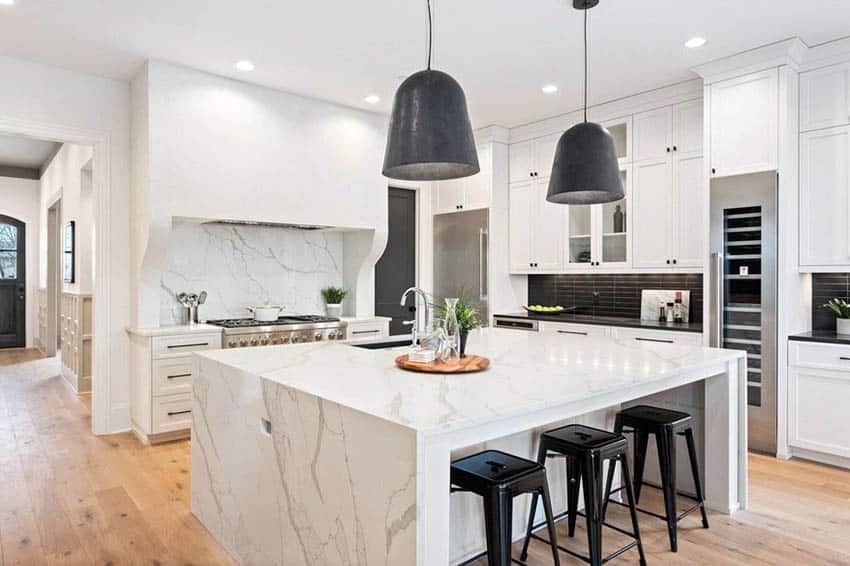
For those who prefer an eco-friendly option, butcher block countertops are a wonderful choice. These wooden countertops offer a natural, warm feel that complements the coolness of white cabinets beautifully. The wood grains add texture and an organic touch to the space, making the kitchen feel cozier and more inviting. Although butcher block requires regular maintenance, like oil to prevent the wood from drying out, it develops a rich patina over time that can make the kitchen even more charming. One of the best things about butcher block is that you can sand down any scratches or marks, so it’s a great option for those who love the idea of a countertop that can evolve with the home.
If you’re into a more industrial, contemporary aesthetic, concrete countertops are also worth considering. Concrete offers an urban, minimalist vibe, and when combined with white cabinets, it creates a clean, modern look. One of the best things about concrete is that it can be customized to fit any kitchen size and shape. You can also choose different finishes, from polished to matte, and even add pigments to change the color of the concrete. Although concrete can be prone to cracking if not properly installed or sealed, its unique look and versatility make it a trendy choice for modern kitchens. When done right, concrete can look sleek and high-end, despite its industrial roots.
Another great option for pairing with white cabinets is quartzite. Not to be confused with quartz, quartzite is a natural stone that shares many characteristics with granite but has the luxurious appearance of marble. Quartzite is available in a wide variety of colors, including some soft whites and greys that blend beautifully with white cabinets. One of the benefits of quartzite is that it’s highly durable, more so than marble, and it’s also resistant to heat and scratches. I appreciate quartzite for its subtle elegance – it’s the kind of material that doesn’t scream for attention but still manages to elevate the overall look of the kitchen.

When selecting a countertop, it’s also essential to consider how much contrast you want to create between the countertop and the cabinets. If you prefer a monochromatic look, choosing a countertop in a similar shade to the cabinets, such as white quartz or marble, can create a seamless and airy feel. This approach works well in kitchens that don’t get a lot of natural light because the uniform light colors reflect light around the room, making the space feel larger and more open. On the other hand, if you want to create contrast, you can opt for darker countertops, like black granite or soapstone. This contrast can help ground the space and give the kitchen a more dramatic, defined look.
For a balanced approach, consider choosing a countertop with subtle veining or flecks of color. This middle ground gives the kitchen some visual interest without overwhelming the space with too much contrast. For instance, a light grey quartz countertop with faint white veining can provide just enough differentiation while maintaining the airy, cohesive feel of an all-white kitchen. Similarly, a granite countertop with a mix of white, grey, and black specks can tie together different elements in the kitchen, creating harmony between the white cabinets and other design features.
One of my favorite ways to add personality to a kitchen with white cabinets is by incorporating a statement countertop. Materials like soapstone, which darkens over time, or bold-colored quartz, can serve as a focal point in the room. Soapstone, in particular, has a rich, almost velvety texture, and its dark, matte finish contrasts beautifully with white cabinets. Over time, soapstone develops a patina that can range from charcoal grey to deep black, giving the kitchen a lived-in, timeless quality. It’s also non-porous and resistant to heat, which makes it a practical choice as well as a stylish one.
Another fun approach to pairing countertops with white cabinets is mixing materials. You don’t have to stick with just one type of countertop in the entire kitchen. For instance, you could use a durable material like quartz or granite for the main workspaces, where you do most of your cooking, and then opt for something more decorative, like a butcher block, on an island or a smaller section of the kitchen. This not only adds visual interest but also allows you to combine the best qualities of different materials to suit the various functions of your kitchen.
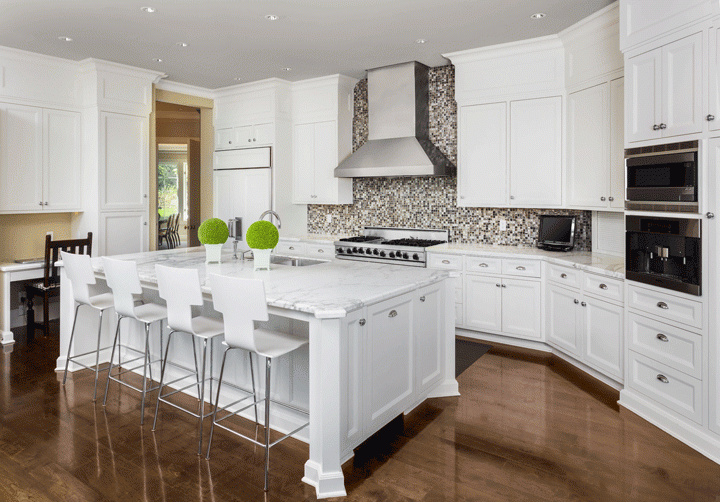
Ultimately, the right countertop for your kitchen will depend on your personal preferences, lifestyle, and the overall look you’re trying to achieve. If you’re someone who cooks a lot or has kids, you might prioritize durability and easy maintenance, in which case materials like quartz, granite, or quartzite would be excellent choices. If aesthetics are your main concern, and you’re willing to put in a little extra effort to maintain them, marble or butcher block might be more your style. Either way, white cabinets provide the perfect backdrop for showcasing your countertop of choice.
As you decide on the right countertop, also think about the long-term maintenance. Some materials require more upkeep than others, like sealing granite every few years or oiling butcher blocks regularly. Knowing your maintenance tolerance ahead of time can help guide your decision and ensure that your kitchen remains as beautiful and functional as the day it was installed.
At the end of the day, pairing white cabinets with the right countertop can transform your kitchen into a space that’s not only functional but also reflective of your style. Whether you choose something classic like marble or go for a more modern material like quartz, the combination of white cabinets and a well-chosen countertop is a surefire way to create a kitchen that’s both timeless and trendy.
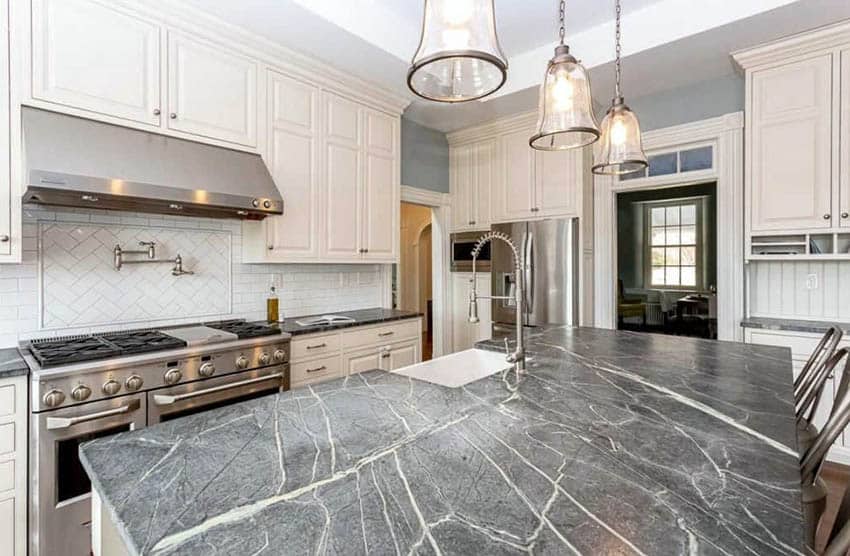
Common Mistakes to Avoid
When choosing a countertop to pair with white cabinets, there are a few common pitfalls you’ll want to steer clear of. One mistake is focusing solely on appearance without considering the practicality of the material. A countertop may look stunning, but if it requires more maintenance than you’re willing to give, you may end up regretting your decision down the line.
Another mistake is neglecting the contrast or lack thereof. Too much contrast can make the space feel busy, while too little can make it appear washed out. Striking the right balance is key. Many people also underestimate how different countertops look under various lighting conditions. Make sure to see your countertop material in the lighting of your kitchen before making a final decision. Finally, skimping on professional installation can lead to long-term issues like uneven surfaces or cracks, particularly with materials like concrete or marble.
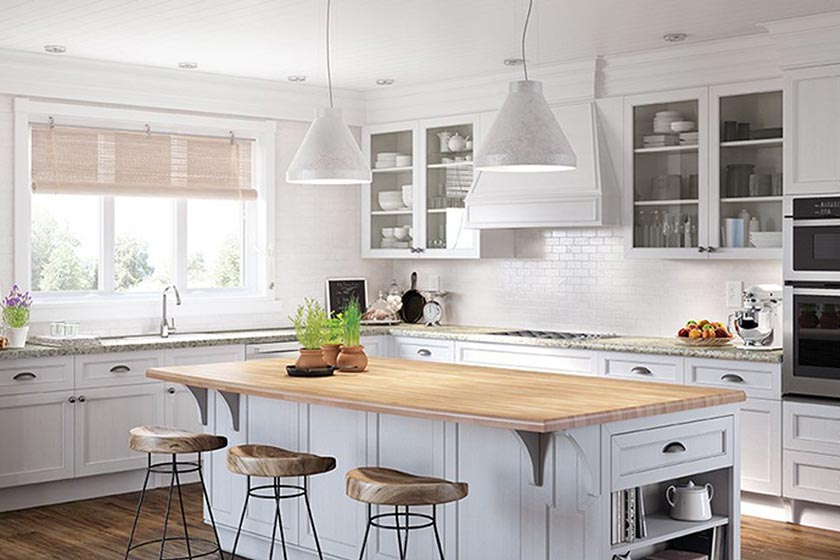
What is the best countertop material to pair with white cabinets?
The best material depends on your lifestyle and aesthetic preferences. Quartz and granite are great for durability and low maintenance, while marble and butcher blocks offer a more luxurious or rustic appeal. Each material has unique qualities that can complement white cabinets beautifully.
Can I mix and match countertop materials in my kitchen?
Yes, mixing materials is a creative way to add variety and function to your kitchen. For example, you could use a more durable material like quartz for high-traffic areas and a decorative option like butcher block on an island for added warmth and character.
How do I create contrast with white cabinets and countertops?
To create contrast, consider darker materials like black granite, soapstone, or concrete. Alternatively, you can opt for countertops with subtle veining or specks of color to add dimension without overwhelming the space.

Are marble countertops practical for a busy kitchen?
Marble can be practical, but it does require more maintenance than other materials. It’s prone to scratching and staining, so it’s best suited for kitchens where appearance is prioritized over high-traffic functionality. Regular sealing and careful use can help maintain its beauty.
Do concrete countertops crack easily?
Concrete countertops can crack if not properly installed or maintained, but modern techniques have made them more durable. Regular sealing helps prevent cracks, and minor cracks are often considered part of concrete’s natural charm.
How do I maintain butcher block countertops?
Butcher block requires regular oiling to prevent the wood from drying out and cracking. Scratches can be sanded out, and spills should be wiped up immediately to prevent stains. With proper care, butcher blocks can develop a beautiful patina over time.

Granite Colors That Go Perfectly With White Cabinetry
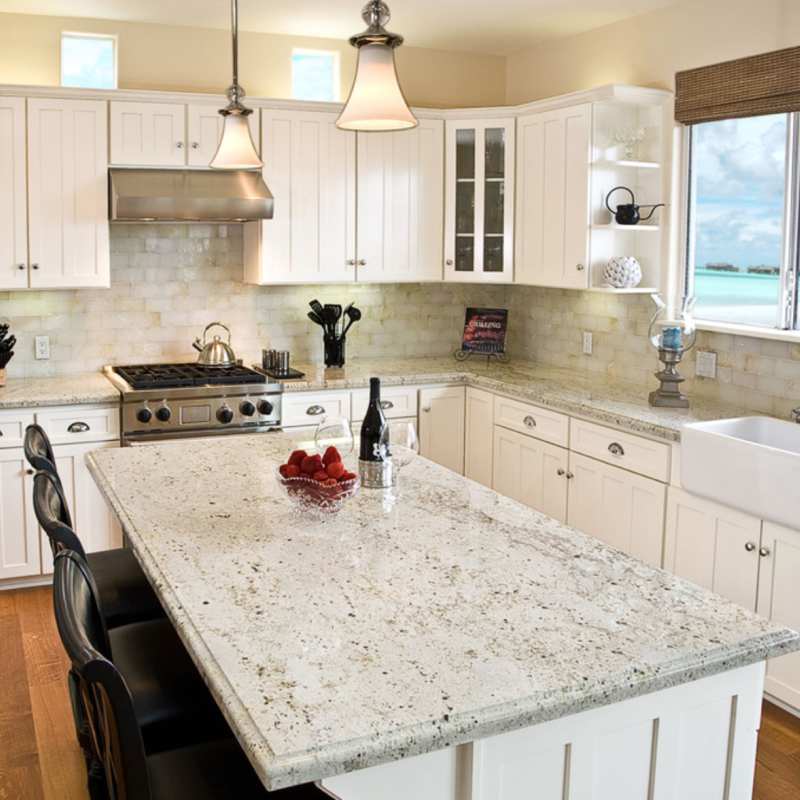
Related articles: